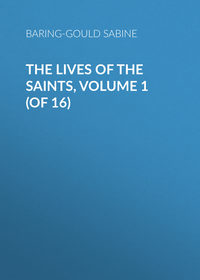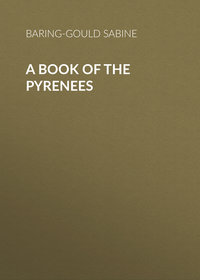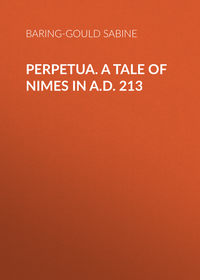 полная версия
полная версияThe Lives of the Saints, Volume II (of 16): February
On the death of Flavius, the clergy and people, with the king's consent, proceeded to elect Solemnis to fill the vacant see; but he, knowing their intention, fled, and hid himself in a cave outside the city. When he could not be found, the electors with one consent shouted, "Aventine is worthy!" that being the customary formulary of election. Thereupon, Aventine, much against his will, was drawn into the cathedral, and ordained priest, and consecrated bishop. Now Solemnis, from his place of retreat, heard the shout in the city, and knew that a bishop had been chosen. Yet he waited till he saw peasants returning along the road that ran by his retreat, and he overheard them speaking of the consecration of his brother Aventine. So he, deeming all further concealment unnecessary, came forth, and entered the city. Then, at once, a crowd surrounded him, and the roar of a thousand voices proclaimed, "Solemnis is worthy! Solemnis shall be bishop!" And he was drawn to the cathedral, vested in white, a mitre placed on his head, the pastoral staff put into his hands, and the bishops of the province there present, proclaimed him. And when this was done, men asked, "What shall be done with Aventine?" and he was sent to be bishop of Chateaudun, his native town. Then he went his way. And as he drew near to the city, there met him a leper, who ran towards him, and stopped, and cried out, "I am John, thy brother." He would have rejoiced to meet his brother, had he not seen that he was afflicted with leprosy; for which reason John had retired from the city, and fled from the society of men. Then the bishop ran to him, and fell on his neck, and his tears flowed over him, and he kissed him; and the flesh of John came again as the flesh of a little child, and he was made perfectly whole.
Of the works of the holy Aventine in his diocese little is known, save that he laboured in season and out of season in the ministry of God, and that he lived in a little cell outside the city gates, in the face of a rock. After the death of Solemnis, about 509, Aventine governed the whole Chartrain Church, and subscribed the council of Orleans, 511, as bishop of Chartres. Relics translated in 1853 to the parish church of S. Madeleine in Chateaudun.
S. THEOPHILUS THE PENITENT(ABOUT A.D. 528.)[Commemorated by the Greeks on this day. Not by the Westerns, though the story is quoted by a great number of Latin writers. Authority: – The Greek account by Eutychianus, who pretends to have been a disciple of Theophilus, and declares that he relates what he had seen with his own eyes, and heard from the mouth of Theophilus himself. Metaphrastes embodied the narrative of Eutychianus in his great collection of the Lives of the Saints. For a full account of this strange story, see my "Myths of the Middle Ages."]
The following story must be received with caution. It has not received the sanction of the Western Church, and is probably a mere religious romance. It was very popular in the middle ages, and was frequently represented in sculpture and stained glass.
A few years before the Persian invasion, in 538, there lived, in the town of Adana in Cilicia, a priest named Theophilus, treasurer and archdeacon. He lived in strict observance of all his religious duties, was famous for his liberality to the poor, his sympathy with the afflicted, his eloquence in the pulpit, his private devotion, and severe asceticism. On the decease of the bishop, by popular acclamation he was summoned to the episcopal oversight of the diocese, but his deep humility urged him to refuse the office, even when it was pressed upon him by the metropolitan. A stranger was raised to the vacant seat, and the treasurer resumed the course of life he had pursued for so many years with credit to himself and advantage to the diocese, content in his own mind with having refused the office, which might have aroused his pride, and which certainly would have diminished his opportunities of self-sacrifice. Virtue invariably arouses the spirit of detraction, and Theophilus, by his refusal of the bishopric, was thrust into public notice, and attracted public attention. The consequence was, that the evil-minded originated slanders, which circulated widely, produced a revulsion of feeling towards Theophilus, and, what was generally reported, was accepted as substantially true. These stories reached the ears of the new bishop, he sent for the archdeacon, and, without properly investigating the charges, concluded he was guilty, and deprived him of his offices.
One would have supposed that the humility which had required the holy man to refuse a mitre, would have rendered him callous to the voice of slander, and have sustained him under deprivation. But the trial was too great for his virtue. He brooded over the accusations raised against him, and the wrongs inflicted upon him, till the whole object of his desire became the clearing of his character. He sought every available means of unmasking the calumnies of his malingers, and exposing the falsity of the charges raised against him. But he found himself unable to effect his object; one man is powerless against a multitude, and slander is a hydra which, when maimed in one head, produces others in the place of that struck off. Baffled, despairing, and without a friend to sustain his cause, the poor clerk sought redress in a manner which, a month before, would have filled him with horror. He visited a necromancer, who led him at midnight to a place where four cross-roads met, and there conjured up Satan, who promised to reinstate Theophilus in all his offices, and, what he valued more, to completely clear his character. The priest, to obtain these boons, signed away his soul with a pen dipped in his own blood, and abjured for ever Jesus Christ and His spotless Mother.
On the morrow, the bishop, discovering his error, how we know not, sent for Theophilus, and acknowledged publicly that he had been misled by false reports, the utter valuelessness of which he was ready frankly to acknowledge; and he asked pardon of the priest, for having unjustly deprived him of his office. The populace enthusiastically reversed their late opinion of the treasurer, and greeted him as a Saint and confessor.
For some days all went well, and in the excitement of a return to his former occupations, the compact he had made was forgotten. But after a while, as reason and quietness resumed their sway, the conscience of Theophilus gave him no rest. His face lost its colour, his brow was seamed with wrinkles, an unutterable horror gleamed out of his deep-set eyes. Hour by hour he prayed, but found no relief. At length he resolved on a solemn fast of forty days. This he accomplished, praying nightly in the Church of the Blessed Virgin, till the grey of morning stole in at the little window of the dome, and obscured the lamps. On the fortieth night, the Blessed Virgin appeared to him, and rebuked him for his sin. He implored her pardon and all-prevailing intercession, and this she promised him. The following night she re-appeared, and assured him that Christ had forgiven him at her prayer. With a cry of joy he awoke; and on his breast lay the deed which had made over his soul to Satan, obtained from the evil one by the mercy of the holy Mother of God.
The next day was Sunday. He rose, spent some time in acts of thanksgiving, and then went to church, where the divine liturgy was being celebrated. After the reading of the Gospel, he flung himself at the bishop's feet, and requested permission to make his confession in public. Then he related the circumstances of his fall, and showed the contract signed with his blood to the assembled multitude. Having finished his confession, he prostrated himself before the bishop, and asked for absolution. The deed was torn and burned before the people. He was reconciled, and received the blessed Sacrament; after which he returned to his house in a fever, and died at the expiration of three days. The story is probably a mere religious romance.
S. MODAN, AB(7TH CENT.)[Aberdeen Breviary: – from which almost all that is known of his life is gathered.]
S. Modan was first monk, and then abbot of Mailros, in Scotland, and preached the faith in Stirling and at Falkirk. When old he retired among the mountains of Dumbarton, and there died. His body was kept till the change of religion, with honour, in the church of Rosneath.
B. HRABANUS MAURUS, B. C(A.D. 856.)[From his life by Rodolph the priest, monk of Fulda, d. 865; and various writers of a later period.]
Rabanus, or Hrabanus Maurus, was one of the most illustrious writers of the 9th century. He was born at Mainz, in the year 788. When very young he was sent to the monastery of Fulda, where he was brought up. From thence he was sent to Tours, where he studied for some time under the famous Alcuin. He returned afterwards to Germany, into his monastery, where he was entrusted with the government of the novices, was afterwards ordained priest in the year 814, and at last chosen abbot of Fulda, in 822. After he had managed this charge twenty years, he voluntarily quitted it, to satisfy the monks, who complained that his studies so engrossed his time that the affairs of the monastery were neglected. He retired to Mount S. Peter, and was shortly after chosen archbishop of Mainz or Mayence, in the year 847. He held a council in the same year for the reformation of discipline; and died in 856.
As a mystical interpreter to Holy Scripture, his commentaries will ever be read. He was a voluminous writer on various subjects, sacred and profane, and was certainly one of the most learned men of his day.
S. NICOLAS OF THE STUDIUM, C(A.D. 868.)[Greek Menæa for this day. Authorities: – Life by a contemporary monk in his monastery.]
This glorious confessor was born in Crete, and was the son of pious parents, who educated him from earliest infancy in the fear of God. At the age of ten he was sent to Constantinople, to see his kinsman Theophanes. He found him a monk of the order of the Sleepless Ones,16 in the monastery called the Studium. He entered the same order, and fulfilled his monastic duties with regularity and devotion. Having set a brilliant example, he was deemed worthy to be invested with the priesthood. Then broke out the furious persecution of the Iconoclasts, about which a few words must be said in this place.17
When God was made Man, He was put at once into the most intimate relation with men; and just as it is lawful for any son to have a portrait of his father or mother, so did it become lawful and reasonable that he should have a picture of that God-Man, who is dearer to him than father or mother. The picture served as a constant reminder, an evidence for the Incarnation. It is a sermon declaring God to be made Man. But the Arians, who denied the divinity of our Lord, were most hostile to sacred representations of Christ, and with reason, for these pictures were a testimony against them. At first the Arian attack on the foundation doctrine of the Incarnation was open. But, when the theological statement of that mystery was made so plain that there was no opposing it by counter statement, Arianism adopted other tactics, and appeared as Iconoclasm, or war against sacred pictures. He who disbelieved, or only coldly acquiesced in the Incarnation of God, saw that this chief corner-stone of Christianity could only be uprooted by chilling the ardour of Christian affection. And no better method of chilling that affection could be devised, than the obliteration of representations of Christ, His acts, His passion, and of His mother, and His Saints; then there was some prospect of religious acceptance of this dogma sinking into cold intellectual apprehension, and thence it could be dislodged without difficulty. After the reconciliation of large congregations of Gnostics and Arians with the Catholic Church, they maintained that icy worship which had preceded their separation, they adored God as a Spirit, but actually, though they had ceased to do so formally, overlooked His manhood. These reconciled bodies afforded a fund of passive prejudice and aversion of small account so long as Catholic princes were on the throne, but which, in the fortune of a soldier, might produce serious results to the Church.
Of such adventurers, the most fortunate was the Emperor Leo III., who, from the mountains of Isauria, ascended to the throne of the East. He was ignorant of sacred and profane letters; but his education, his reason, perhaps his intercourse with Jews and Arabs, had inspired the martial peasant with a hatred of images; and he held it to be the duty of a prince to impose on his subjects the dictates of his own conscience. In the reformation of religion, his first steps were moderate and cautious; he assembled a great council of senators and bishops, and enacted, with their consent, that all the images should be removed from the sanctuary and altar to a proper height in the churches, where they might be visible to the eyes, and inaccessible to the devotion of the people. But it was impossible on either side to check the rapid though adverse impulses of veneration and abhorrence: in their lofty position, the sacred images still edified their votaries, and exasperated their enemies. He was himself provoked by resistance and invective; and his own party accused him of an imperfect discharge of his duty, and urged for his imitation the example of the Jewish king, who had broken without scruple the brazen serpent of the temple. By a second edict, he proscribed the existence, as well as the use of sacred pictures; images of Christ, the Blessed Virgin, and the Saints, were demolished, or a smooth surface of plaster was spread over the walls of the edifice. The sect of the Iconoclasts was supported by the zeal and despotism of six emperors, and this topic involved the East and West in an angry conflict of one hundred and twenty years. It was the design of Leo the Isaurian to pronounce the condemnation of images as an article of faith, and by the authority of a General Council; but the convocation of such an assembly was reserved for his son Constantine Copronymus. This council was attended by three hundred and thirty-eight bishops of Europe and Anatolia, but not by those of the Western Church, African Church, or that of Palestine. It was, in fact, an assembly of those prelates who were weak enough to assist, fearing condemnation and exile if they did not submit, ambitious enough to follow the caprice of the reigning emperor, in hopes of emolument, and also of those who heartily concurred with his semi-Arianism. After a serious deliberation of six months, the prelates subscribed such a decree as the emperor desired, condemning all visible symbols of Christ,18 except the Eucharist, as blasphemous and heretical; and denouncing veneration for images as the idolatry of Paganism. "As if," says a Catholic writer of the time, "there were not this great difference between the Christian image and the heathen idol, that the latter is the thing worshipped, whereas the former is the representation of the person adored."
The first hostilities of Leo had been directed against a lofty Christ on the vestibule, and above the gate, of the palace, placed there to exhibit to all men that the emperors had bowed before the King of kings. A ladder had been placed for the assault, but it was shaken by a crowd of women and zealots, and for their opposing the execution of the mandate, severe and savage reprisals were taken. The execution of the imperial mandates were resisted by frequent tumults in Constantinople and the provinces, which were quelled by the military, and much blood flowed.
In the cruel persecution that ensued, the monks, ever the champions of the Incarnate God, suffered most severely. Nicolas of the Studium, together with S. Theodore, the abbot, or archimandite, of the monastery were called to suffer. Nicolas was scourged with leather thongs on the back and limbs, and his arms extended, so that they became for a time paralysed. His back, which was lashed and bleeding, was tenderly bathed with warm water and healing lotions by S. Theodore, his superior, till it was healed. Both were driven into exile, and kept for three years in nakedness, and without sufficient food and drink, in a wretched prison. They were beaten again at Smyrna, and further imprisoned for twenty-two months, with their feet in the stocks. On the death of Leo, the confessors were released, and visited S. Nicephorus at Chalcedon. This took place during the absence of Constantine Copronymus, who had undertaken an expedition against the Saracens. During this absence, his kinsman, Artavasdus, assumed the purple, and everywhere the sacred images were triumphantly restored. Constantine flew for refuge to his paternal mountains; but he descended at the head of the bold Isaurians, and his final victory placed the unfortunate Catholics once more at the mercy of a brutal tyrant. This monster of crime derived his name Copronymus from having defiled his baptismal font. This incident of his infancy was accepted as an augury of his maturity, and he did not belie it. His reign was one long butchery of whatever was most noble, or holy, or innocent, in his empire. In person the emperor assisted at the execution of his victims, surveyed their agonies, listened to their groans, and indulged, without satiating, his appetite for blood: a plate of noses was accepted as a grateful offering, and his domestics were often scourged or mutilated by his royal hand. His long reign was distracted with clamour, sedition, conspiracy, mutual hatred, and sanguinary revenge. The hatred borne by this ruffian against monks and images was implacable. Images were torn down and defaced with wanton malice throughout the empire by an officer called the Dragon, sent round for that purpose; all religious communities were dissolved, their buildings were converted into magazines or barracks; the lands, moveables, and cattle, were confiscated, and the monks were mutilated in eyes and ears and limbs, with refined cruelty.
Under this emperor, Theophilus (829), Nicolas and Theodore again suffered persecution. Theodore, and the abbot Theophanes, kinsman of Nicolas, were mutilated by certain verses being cut upon their brows. During the persecution, S. Nicolas remained concealed; on the accession of the indifferent emperor, Michael III., (842), he emerged from his hiding place, and was elected archimandite of the Studium, the abbot Theodore being dead. After exercising the government for three years, he resigned it to Sophronius, and retired to Firmopolis, that he might pass the remainder of his days in peace; but it was not so to be; after four years he was recalled to the abbacy of the Studium, on the death of Sophronius, and was at once involved in conflict. For the patriarch Ignatius, having rebuked the Cæsar Bardas for incest, and then excommunicated him, the emperor Michael III., his nephew, was persuaded to exile Ignatius, and to intrude Photius into the Patriarchal see. The abbot Nicolas refused to communicate with the intruder, and was consequently driven from his monastery, and a monk, Achillas, was appointed in his room. Nicolas was pursued from one retreat to another by the hostility of the intruded patriarch, and after many wanderings, rested in the Crimea. Upon the death of Bardas and Michael, Bardas having been murdered by his nephew Michael, and Michael by his successor, Basil I., (867), the patriarch Ignatius was recalled, and the patriarch persuaded Nicolas to return to his government of the Studium, where he died the following year.
S. REMBERT, B. C(A.D. 888.)[Roman Martyrology; this being the day of his consecration to the Archbishopric of Bremen and Hamburg. But in some German Martyrologies, on June 11th, the day of his death. Authority: – his life written by a coeval author or authors].
This saint was born at Thourout, in Flanders, where was a monastic cell, that had been given by King Louis the Pious to S. Anskar. As Anskar was at Thourout one day, he noticed some boys going to church, and amongst them was one who, by his gravity, pleased him; and when the boy entered the church, he crossed himself, and behaved with so great reverence, that the archbishop went to him, and asked his name. He told him that he was called Rembert. Then S. Anskar took him and placed him in the little monastery, and bade that he should be well instructed. In after years, the apostle of Sweden called Rembert to assist him in his mission; and he loved his young friend greatly, and prayed to God for three days incessantly that He would grant to Rembert to accomplish the work that he, Anskar, had begun, and to make them companions together in the Heavenly Zion. After Anskar died, in 865, S. Rembert was unanimously chosen Archbishop of Hamburg and Bremen, and he superintended all the churches of Sweden, Denmark, and Lower Germany. He also began a mission to the Wends and Sclavonic race of Mecklenburg and Brandenburg, which was attended with considerable success. He sold the sacred ornaments of the Church to redeem captives from the Northmen. On one occasion he saw a party of these marauders pass, dragging after them a poor girl, who raised her shackled hands towards the bishop, and began to chant one of David's psalms. Then S. Rembert leaped off his horse, and ran to the chief, and offered him the horse if he would release the captive Christian maiden. And this he did, well pleased to obtain so valuable a horse. S. Rembert died on June 11th, in the year 888.
S. GILBERT OF SEMPRINGHAM, AB(A.D. 1189.)[Roman, Anglican, Belgian, Benedictine, and Cistercian Martyrologies. Authority: – his life, by a contemporary, published by Bollandus.]
This S. Gilbert, of whom Henricus Chrysostomus, a Cistercian chronicler, speaks as "a disciple of Bernard the mellifluous, a man of apostolical zeal, of most severe and rigid life, in purity conspicuous, illustrious for his gift of prophecy, and the mirific performer of stupendous miracles," was born about the year a. d. 1083, near the close of the reign of William the Conqueror. From an apparently contemporary pedigree he seems to have been related on the mother's side to that monarch, who may have rewarded the services of his father, "a bold and skilful warrior," with the hand of one of his relations, in addition to the manor of Sempringham, where Gilbert first saw the light. His mother is said to have received, shortly before his birth, a miraculous presage of the future greatness of her child, a greatness, however, of which few external tokens would seem to have manifested themselves during his childhood; since one of his biographers relates that as a child he was so dull and spiritless as to provoke the contempt and ill-usage of even the servants of his father's household. Driven by this maltreatment from his home and country, or more probably sent from home by the care of his parents, who discerned in him a greater aptitude for the cloister than for the camp, he passed some years in Gaul in the peaceful study of letters and philosophy. His childish education completed, he returned to England, and took up his abode with one of his father's dependents. Here he fell in love with the daughter of his host, and gave the first proof of his vocation to the counsels of perfection; for finding his passion increase daily in strength, and fearing lest he should be overcome by it, he fortified his soul by prayer and fasting; and then seeking the company of his beloved, he so wrought upon her by his exhortations and entreaties, that he prevailed upon her to join him in a vow of perpetual chastity, and she was one of the first who afterwards became nuns under his rule.
He now took to keeping a school, and gathered together a number of children of both sexes, to be instructed in the rudiments of religion, and especially taught them to live an orderly and pious life in the world, without as yet leading them forward to the higher life of the cloister; and these afterwards became the nucleus (primitiæ plantæ) of his order.
During this time he seems to have lived in the family of the then Bishop of Lincoln, and to have been admitted by him to the minor orders of the ministry; for the next thing related of him is that being presented by his father to the united benefices of Sempringham and Torrington he most willingly accepted the charge, and devoted the whole revenue of his livings to charitable purposes. Such was the fervour of his devotion at this time, that it is related that having one day invited one of his companions to join him in his prayers, the youth was so fatigued by the length of the office, and the punctilious care with which Gilbert genuflected whenever the holy names of God and of Christ occurred, that he swore he would never pray with him again.









